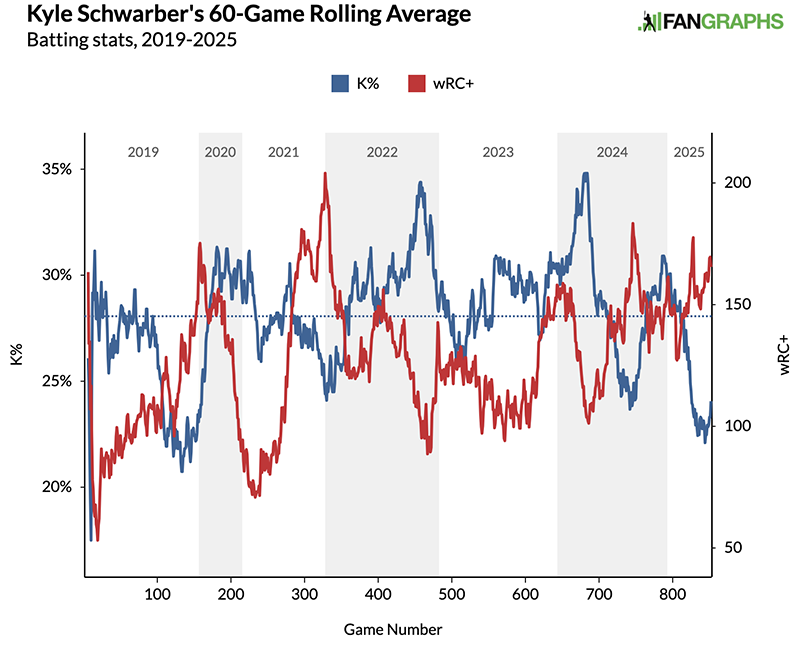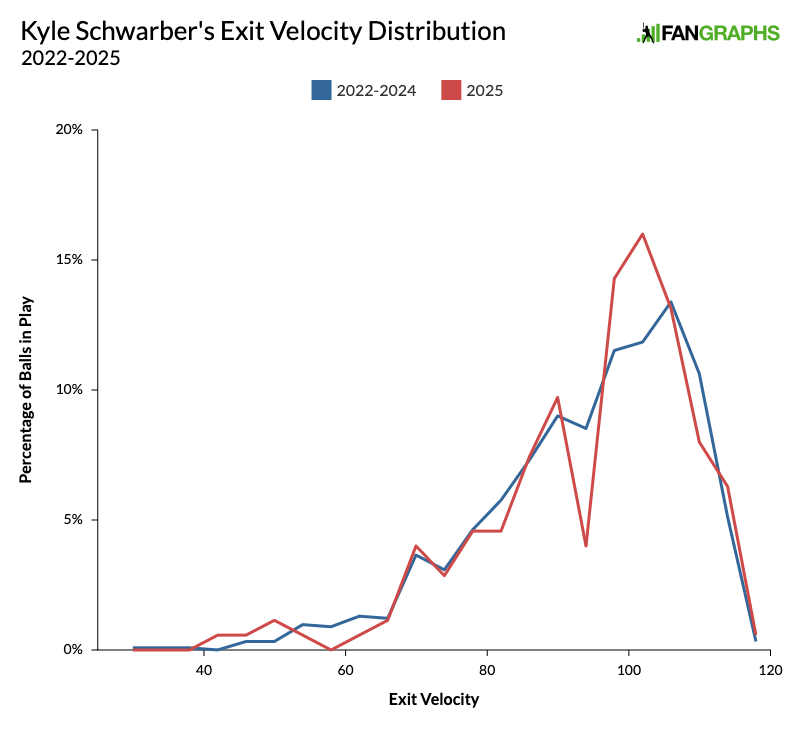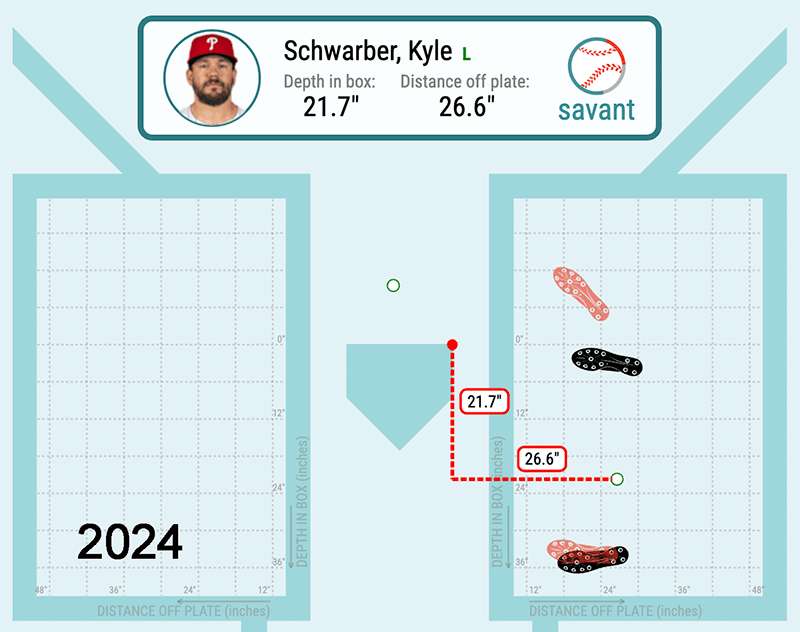Kyle Schwarber Is Dominating the Heart of the Plate

When I wrote a few weeks ago about how Kyle Schwarber deserves to be the first player in baseball history to get not his own bobblehead doll, but rather his own bobble helmet doll, I neglected to mention one thing. Schwarber has been brilliant this season. He’s off to the best start of his entire career. Schwarber is currently running a 164 wRC+, which makes him the eighth-best qualified hitter in baseball. His 19 home runs and 16% walk rate both rank in the top five. That excellent spring is all the more impressive considering that Schwarber is, relatively speaking, something of a slow starter. He owns a career 110 wRC+ in March and April, followed by a 115 mark in May, then a 145 mark in June. This season, he just started out hot and got even hotter. Here’s a table that shows his wOBA in March and April through his entire career:
| Year | wOBA | |
|---|---|---|
| 2016 | .138 | |
| 2017 | .278 | |
| 2018 | .372 | |
| 2019 | .315 | |
| 2021 | .329 | |
| 2022 | .315 | |
| 2023 | .313 | |
| 2024 | .344 | |
| 2025 | .423 |
Schwarber has had plenty of hot streaks like this one before, but never to lead off a season. Moreover, the way he’s doing it is different. With Joey Gallo attempting to reinvent himself as a pitcher, Schwarber stands alone as the game’s foremost practitioner of the Three True Outcomes, but he’s doing his best to abandon one of those outcomes. He’s currently running a 24.4% strikeout rate, which would represent the lowest rate of his career and a drop of more than four percentage points compared to last season. In addition to lowering his strikeout rate, Schwarber is doing more damage than ever when he puts the ball in play. His .499 wOBAcon and .531 xwOBAcon are the best marks of his entire career.
Let’s start with Schwarber’s strikeout rate, and we’ll get to contact quality later on:

What Schwarber’s doing isn’t unprecedented, either in terms of his strikeout rate or overall production. Still, the last time he had a stretch this long where he struck out this little, we were in different decade. Moreover, back when he was striking out this infrequently, he wasn’t hitting this well.
The numbers show some obvious reasons that Schwarber might be striking out less. For starters, 40% of the pitches he’s seen have been on the edge of the strike zone. Schwarber has always run low edge rates, but that’s the lowest mark of his career, and it’s below 90% of qualified players. It’s probably just randomness that will regress to the mean some. For now, though, it has likely made Schwarber’s swing decisions just a bit easier.
Intent is clearly a part of it too, though. Schwarber is swinging at the first pitch he sees just 20.4% of the time, the lowest mark of his career by nearly three percentage points. He’s always been one of the game’s most patient hitters, but that’s a pretty clear sign that he’s either trying to see even more pitches or that he’s looking for something very specific.
Schwarber’s overall swing rate is down and his 19.4% chase rate is the lowest of his career by more than a full percentage point. Put those together and his CSW rate – that’s the percentage of pitches that go for called or swinging strikes – is right at his career average of 29.4%, with extra called strikes taking the place of the drop-off in whiffs. However, 42.9% of the pitches Schwarber sees are going for strikes overall, as are 64.5% of his swings. Those are both the lowest marks of his career, and it’s because a career-low 33.6% of the pitches he swings at end up as foul balls.
That brings us to contact quality, which is where things get really interesting. Schwarber is being a bit more patient, especially on the first pitch. He’s making more contact overall, and more of that contact is coming on balls in play, rather than foul balls.
Last year, I did some research on foul balls, and this was one of my takeaways: “Sluggers with big swings and big whiff rates hit fewer foul balls. When they miss, they miss big. Players with great bat control who hit for high averages also foul off more pitches. They frequently manage to put the bat on the ball, even if they don’t always make solid contact when they connect.” However, Statcast’s new bat tracking data says that Schwarber is heading in the opposite direction.
Schwarber’s average and 90th-percentile exit velocities are almost exactly the same as they were last season, but his hard-hit rate is up by nearly four percentage points. In order to show you what that means, I took every batted ball Schwarber has hit over the last four seasons and put them in buckets of 4 mph. It’s not a perfectly smooth distribution, but I think it makes a pretty clear point:

Schwarber’s top-end power hasn’t changed at all, but when he’s able to hit the ball hard, he’s really hitting it hard. He’s hitting more balls around 100 mph and fewer around 95. This coincides with some subtle changes to his bat tracking data. Schwarber’s swing path and attack angle look pretty much identical over the past three seasons. However, this season, he’s squaring the ball up more with a slightly shorter and slower swing:
![]()
That might make it sound like Schwarber is dialing back his swing, but I’d remind you that many of these bat speed metrics are also timing and location metrics. Because your bat accelerates during your swing and you need to meet inside pitches further in front, a lower bat speed and a shorter swing can just mean that you’re meeting the ball deeper or swinging at fewer inside pitches. Schwarber is actually meeting the ball slightly farther in front, but he’s focused on a slightly different part of the zone.
Pitchers have always attacked Schwarber away, and this season he’s more willing to swing at those pitches and less willing to swing at elevated fastballs. The heat maps below show Schwarber’s swing rate, and it’s easy to see the way the red zone has shifted away and down:

Looking at this chart, it seems clear that Schwarber isn’t really swinging softer. The Statcast data says he’s setting up an inch closer to the plate this season, and the drop in bat speed is mainly a result of the pitches he’s swinging at. This also explains why Schwarber is meeting the ball farther out front and pulling it more even though he’s swinging at pitches that are farther away. Higher pitches, especially high and inside pitches, are harder to get around on. Swing at fewer of them, and your contact point will likely shift forward, even if the pitches are located slightly farther outside. And because Schwarber is setting up slightly closer to the plate, those pitches aren’t quite as far outside, relatively speaking, as they once were. It’s a subtle shift, but it’s visible. The two white and green dots are Schwarber’s center of mass and his average intercept point:

There’s one more factor that I find really interesting. Over at Baseball Prospectus, Timothy Jackson wrote about some revealing quotes in which Schwarber describes the thought process behind his swing decisions. “I think the biggest thing is not trying to hit their pitch,” he said. “You’re trying to hit their mistake.” Knowing that, take a look at the graph below. It shows Schwarber’s year-over-year performance just on pitches over the heart of the plate:

Schwarber’s a completely different player against pitches in the heart of the zone. In terms of Statcast’s run value, even though we’re only a third of the way through the season, he’s already been way more valuable there than he was in any previous season. He’s been worth 4.9 runs per 100 pitches, which trails only Aaron Judge (9.7) and Shohei Ohtani (5.0). Just two years removed from being a net negative against these pitches, Schwarber is literally one of the best hitters in baseball against them.
What is he all of a sudden doing so well when the ball is pitched over the heart of the plate? His 20% whiff rate is pretty much the same as last year’s, so that’s not it. He’s actually taking a bit more than he did last year, resulting in more called strikes, which hurts his run value. It’s not that he’s waiting for fastballs; he’s actually swinging at them slightly less. What he’s doing right is hitting the bejeezus out of the ball. His 98.5 mph exit velocity is the highest of his career, and his 79.5% hard-hit rate is the highest ever recorded in the Statcast era. In the past 11 years, no player has ever been more likely to hit a ball over the heart of the plate hard than Kyle Schwarber is this season.
I don’t have a perfect theory that ties these three threads together. Schwarber is being more selective, perhaps aided by the fact that he’s seen fewer pitches on the edge of the plate where he has to make a tough decision. He’s also shifted his focus down, swinging at fewer fastballs in the upper third of the zone. This approach is clearly working. He’s squaring the ball up and making more hard contact than ever before. But I really can’t say for certain whether it will hold over the long term. Maybe Schwarber’s just seeing the ball well right now, which helps both his swing decisions and his power. Maybe the edge rate thing is a fluke and won’t last. Maybe pitchers will change their approach as they see him swinging less at high and inside pitches. Over his last three games, Schwarber has reached base just once and struck out six times. Every hot streak eventually comes to an end, and if Schwarber’s reaching that point now, I’ll be really curious to see what happens next.
Davy Andrews is a Brooklyn-based musician and a writer at FanGraphs. He can be found on Bluesky @davyandrewsdavy.bsky.social.
Great article! I know it’s not a Judge piece, but man, this stat: ‘He’s been worth 4.9 runs per 100 pitches, which trails only Aaron Judge (9.7) and Shohei Ohtani (5.0). ‘
Almost doubling your nearest competitor is crazy.